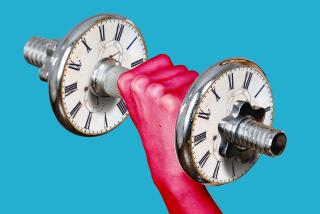Aging Exercisers Afflicted by ‘Boomeritis’
WASHINGTON — “Boomeritis” isn’t a formal medical condition, but Dr. Nicholas A. DiNubile has seen enough boomers with exercise injuries to want to call it something.
“There is a mini-explosion of these injuries,” said DiNubile, an orthopedic surgeon at the Hospital of the University of Pennsylvania, Philadelphia.
“Even though we are a sedentary country, there is one segment that the message [about exercise] has hit, and it’s the baby boomers,” DiNubile said.
The problem is that many boomers have the message garbled, hearing about the benefits of exercise but not listening to their own bodies tell them their limits, DiNubile said.
Exercise will reduce the risk of ailments from heart disease to diabetes. But “trying to do at 50 what you did at 20 is going to get you into trouble,” DiNubile said.
DiNubile spoke about boomers’ sports injuries at a recent meeting of the American Academy of Orthopedic Surgeons. Although no one keeps a national tally on boomers’ injuries, other doctors also say they are seeing more cases as the generation ages.
It’s the standard overuse trauma--torn muscles, tendons and ligaments, and damage to joints. But aging bodies are quicker to develop the injuries, DiNubile said.
“It’s probably a larger problem for weekend people who want to look and feel like they did in their 20s,” said Dr. Clarence L. Shields of the Kerlan-Jobe Orthopedic Clinic in Los Angeles. “They are unable to do so because they have lost some of their flexibility, strength and endurance.”
Even older pros have these problems, Shields said. “The level of intensity that they have taken to their sport always has been very high,” he said. “It’s difficult for them to perform or enjoy a sport at a lower level. They had the mentality that if you have no pain, you made no gain.”
Pro or amateur, boomers have to realize that their reaction time has lengthened, their joints lack the easy lubrication they had in youth, and the elasticity of their muscles, tendons and ligaments has diminished, the doctors say.
The Achilles tendon is a good example, DiNubile said. This tough band of tissue that connects the back of the heel to the muscles of the calf and leg becomes fatty and spongy with age. “It’s no longer the pretty white collagen lined up in parallel, but it’s this gritty, amorphous stuff,” he said. “That is a setup. The tendon just tears.”
Also, middle age is when the body’s preexisting weak spots begin to show. Cumulative trauma may develop in a joint, in part because the body’s ability to recover from the stress of exercise is reduced. And getting over an injury takes longer because the body loses some of its recuperative power.
Reducing the risk is easy--to avoid an overuse injury, don’t overuse.
“You have to slow them down and say they must listen to their body,” Shields said. Remaining sore longer after a workout could be a sign of trouble, he said.
Boomers must pay more attention than they did in their youth to warming up muscles, stretching tendons and ligaments, and doing movements to get fluid flowing in joints, the doctors said.
They also may need to add to their major activities by cross-training, DiNubile said. For instance, runners may start upper-body exercises to strengthen the arms they swing as they run, he said.
And those who are planning to take up vigorous exercise or sports after a long break should first tell a doctor about it, so the doctor can make sure the exercise won’t trigger some otherwise-hidden problem, said Dr. Peter Indelicato of the University of Florida.
New exercisers should start slowly, perhaps with the 30 minutes of moderate activity on most days that the federal government recommends as a minimum for better health, Indelicato said. Increases should not exceed 10% of time, distance or intensity in a week, he said.
It also would be wise to get new, good equipment and to hire a teaching pro to reduce the risks of a training problem that could sideline the boomer athlete, Indelicato said.
More to Read
Sign up for Essential California
The most important California stories and recommendations in your inbox every morning.
You may occasionally receive promotional content from the Los Angeles Times.










